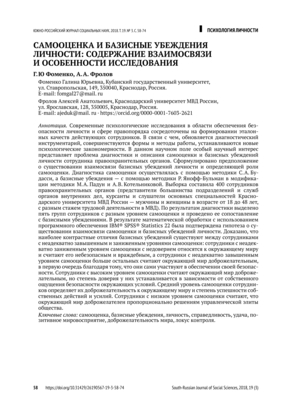Abstract
Modern psychological research in the sphere of ensuring personal safety and law-and-order domain focuses on shaping standard qualities for the personnel. In this connection, it is necessary to update explorative tools, to improve forms and methods of work, and introduce new psychological mechanisms. The diagnostics and description of self-assessment and basic personal beliefs of those who work in law-enforcement agencies are of special scientific interest. The authors of the paper put forward the hypothesis about the connection of basic personal beliefs and the determining role of self-assessment. The diagnostics of self-assessment was carried out with the help of methodology worked out by S. A. Budassi. Personal beliefs were analyzed on the basis of M. Padun and A. Kotel’nikova’s methodology modified by R. Yanoff-Bul’man. The research is based on the selection provided by polling 400 employees of law-enforcement agencies representing most subdivisions of Internal Affairs Agencies, as well as cadets and attendees of Krasnodar University of IAA, both males and females (18–48 years of age), with different employment period in IAA. As a result, five groups of employees with different levels of self-assessment have been extracted. The data obtained in the course of analysis were compared with basic beliefs. Processing the data with the help of IBM® SPSS Statistics 22 has verified the authors’ hypothesis about the inner connection between self-assessment and basic personal beliefs. It has been proved that the most radical differences exist between the employees with overestimated and underestimated levels of basic personal beliefs. The first group of employees mistrusts reality and consider the surrounding world unsafe and hostile; the second group think that the world around is friendly, especially because they themselves participate in ensuring their own safety. Yet the level of friendliness depends on their perception of safety in the surrounding world. The average rate of self-assessment predetermines their goodwill towards reality and the level of their efficiency. The second group considers that reality is friendly in proportion to the decisions taken / made by the administrative elite of the society.
Keywords
References
Бернс, Р. (2008). Я‑концепция и Я‑образы. В Д.Я. Райгородский (ред.) Самосознание и защитные механизмы личности. Хрестоматия (с. 133–219). Самара: Бахрах-М.
Бороздина, Л.В. (1999). Теоретико-экспериментальное исследование самооценки: дис. … д-ра психол. наук. Москва.
Гловер, Э. (1999). Фрейд или Юнг. СПб.: Академический проект.
Зимбардо, Ф. (2008). Формирование самооценки. В Д.Я. Райгородский (ред.) Самосознание и защитные механизмы личности. Хрестоматия (с. 282–296). Самара: Бахрах-М.
Знаков, В.В. (2016). XXI век: Изменения в мире человека и новый этап развития психологии субъекта. В Личность и бытие: человек как субъект социокультурной реальности (Материалы Всероссийской научно-практической конференции (9–10 сентября 2016 г.)) (с. 5–14). Краснодар.
Карабаш, Д.В. (2015). Формирование жизненных и профессиональных ценностных ориентаций личности в процессе обучения в образовательной организации МВД России. Вестник Краснодарского университета МВД России, 4 (30), 246–249.
Мещеряков, Б. Г, Зинченко, В.П. (ред.). (2009). Большой психологический словарь. Москва: АСТ.
Никиреев, Е.M. (2007). Психологические особенности направленности личности. Москва: Московский психолого-социальный институт.
Павлова, С.А. (2014). Формирование эмоциональной устойчивости у сотрудников органов внутренних дел. В Акмеология. Специальный выпуск (Материалы IX Международной научной конференции «Акмеология: личностное и профессиональное развитие человека» (1 июня–15 июля 2014 г.)) (с. 175–176). Москва.
Падун, М.А., Котельникова, А.В. (2008). Модификация методики исследования базисных убеждений личности Р. Янофф-Бульман. Психологический журнал, 29 (4), 98–106.
Рябикина, З.И., Фоменко, Г.Ю. (2010). Личность в профессии: теоретико-эмпирическая интерпретация в контексте субъектно-бытийного подхода. В Л.Г. Дикая, А.Л. Журавлев (ред.) Социальная психология труда теория и практика (с. 82–101). Москва: Издательство «Институт психологии РАН».
Столяренко, А.М. (ред.). (2001). Прикладная юридическая психология. Москва: Юнити-Дана.
Столяренко, Л.Д. (2000). Основы психологии. Издание 3-е, перераб. и дополненное. Ростов-на-Дону: Феникс.
Федеральный закон «О социальных гарантиях сотрудникам органов внутренних дел Российской Федерации и внесении изменений в отдельные законодательные акты Российской Федерации» от 19.07.2011 N247-ФЗ.
Фоменко, Г.Ю. (2004). Парадоксальность как конституирующее качество профессионального бытия психолога. Человек. Сообщество. Управлени, 1, 69–84.
Фролов, А.А. (2016). Исследование взаимосвязи видов самооценки и уровней правового самосознания личности сотрудников правоохранительных органов. Человек. Сообщество. Управление, 17 (2), 26–40.
Baumeister, R.F., Tice, D.M. & Hutton, D.G. (1989). Self-Presentational Motivations and Personality Differences in Self-Esteem. Journal of Personality, 57, 547–579.
Coon, D. & Mitterer, J.O. (2010). Introduction to Psychology: Gateways to Mind and Behavior. Wadsworth Cengage Learning.
Coopersmith, S. (1959). A method for determing types of self-esteem. Journal of Abnormal and Social psychology, 59 (1), 87–94.
Doyle, A.C. (1894). The Memoirs of Sherlock Holmes. London: George Newnes.
Flavell, J.H. (1979). Metacognition and cognitive monitoring: A new area of cognitive–developmental inquiry. American Psychologist, 34 (10), 906–911.
Hofstede, G., Hofstede, G.J. & Minkov, M. (2010). Cultures and Organizations: Software of the Mind. McGraw-Hill.
Kessel, M., Kratzer, J. & Schultz, C. (2012). Psychological safety, knowledge sharing, and creative performance in healthcare teams. Creativity and innovation management, 2 (21), 147–157.
Leeuwenberg, E. & van der Helm, P.A. (2013). Structural information theory: The simplicity of visual form. Cambridge: Cambridge University Press.
Putnam, R. (1995). Bowling Alone: America’s Declining Social Capital. Journal of Democracy, 6 (1), 65–78.
Rogers, C. & Dymond, R. (1957). Psychotherapy and Personality Change. Chicago: University of Chicago Press.
Zimbardo, Р.G. & Sword, R. (2012). Overcome PTSD with new psychology of time perspective therapy. N.Y.: Willey.


